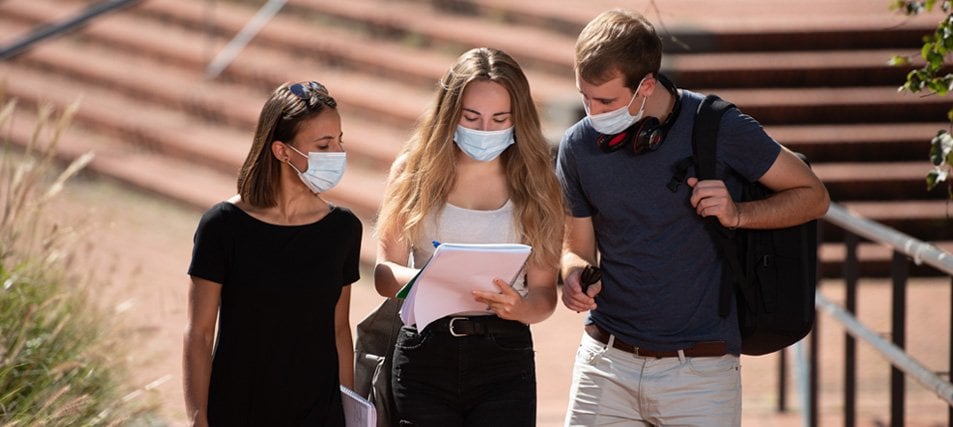Your Financial Aid and COVID-19: What You Need to Know

Changes to college loan interest rates, FAFSA deadlines, and loan repayment options are helping students plan for the potential financial impact of the COVID-19 pandemic. Here's what you need to know to take advantage of these changes.
1. Interest and payments have been suspended on federal student loans through MAY 1, 2022
Student loan relief provided by the Coronavirus Aid, Relief, and Economic Security (CARES) Act has been extended through May 1, 2022. Under the CARES Act, payments on all federally held student loans have been suspended and interest rates have been reduced to 0%. These benefits are automatically applied to your loan. You do not need to contact your loan servicer or do anything else to take advantage of this relief.
If you made a payment toward your federally-held student loans after March 13, 2020 you can request a refund from your student loan servicer. If you are financially able and want to continue making student loan payments, any payments you make after March 13, 2020 will be applied directly to the principal portion of your loan. This will help you repay your college loans faster.
The benefits authorized by the CARES Act apply only to student loans held by the federal government. Private (non-federal) student loans owned by banks, credit unions, schools, or other private entities are not eligible. Some federal student loans are also not eligible, including some Federal Family Education Loans distributed prior to 2010 and Perkins Loans, which were distributed prior to Sept. 30, 2017.
To find out if your student loan is held by the federal government and eligible for the CARES Act relief, contact your loan servicer (the entity to which you make your monthly payment). If you do not know who your servicer is or how to contact them, visit StudentAid.gov.
2. Private lenders may also offer relief
While commercial lenders, schools, and other private entities are not required to suspend interest and payments under CARES, many of these private lenders have allowed borrowers to postpone monthly payments, some for up to 90 days, according to the Consumer Financial Protection Bureau. Others are waiving late fees or offering reduced payment options.
If you have private (non-federal) student loans for college, contact your lender or servicer for more information and to find out what options are available to you.
3. Federal student loan interest rates are lower than ever
Interest rates on federal student loans have dropped significantly due to the pandemic. The interest rate on undergraduate Federal Direct loans dispersed between July 1, 2020 and June 30, 2021 is 2.75%, down from 4.53% in 2019-2020. The interest rate on Federal Direct Plus loans (including Grad PLUS and Parent PLUS loans) is 5.3%, down from 7.08% in 2019-2020. Interest rates on federal student loans are fixed for the life of the loan.
The previous record low for interest rates on federal student loans was set in 2005, when interest rates were as low as 2.875%. The new student loan interest rates do not affect existing student loans, just new loans, and loan fees remain unchanged.
While you cannot refinance existing federal student loans into new federal student loans to take advantage of the lower rates, you may be able to get a lower interest rate by refinancing your federal loans into a private student loan. However, if you do this, you would lose the benefits of federal student loans, such as the current payment pause and interest waiver provided by the CARES Act, death and disability discharges, longer deferments and forbearances, income-driven repayment and loan forgiveness options.
3. You might be eligible for continued work-study benefits
If you started a Federal Work-Study job before your campus closed or moved to online instruction due to the coronavirus and you’re now unable to work your scheduled work-study hours, your school may pay you for this unworked time or allow you to work by another means, such as completing work online or remotely. Contact your school for more information.
If you had not started your work-study job before coronavirus-related disruptions, you may not be eligible for payments of unworked hours. Check with your financial aid office to see if other sources of funding are available.
4. There’s still time to complete the FAFSA
According to Form Your Future, which has been closely monitoring FAFSA completions across the country, the number of high school seniors in the class of 2021 who completed the FAFSA as of November 27, 2020 was down 16.8% compared with last year’s high school senior class. Don’t let the uncertainties of the pandemic stop you from applying for financial aid.
If your or your family’s financial situation has changed significantly (for example, if you’ve lost a job or otherwise experienced a drop in income), it’s not too late to complete and submit the FAFSA form or adjust the form you already submitted. The federal FAFSA deadline for 2020–2021 is June 30, 2021.
Also, some states have extended their FAFSA deadlines for state financial aid. You can check your state’s deadline at studentaid.gov. Some states have hard deadlines and others have suggested dates to make sure you get priority consideration for college money. Since many states have limited funds and offer financial aid only until they run out, the sooner you apply, the better your chances. FAFSA forms are available at Federal Student Aid website.
To find out whether your school has extended its FAFSA deadline for institutional financial aid (aid provided by the college, not the government), contact the school’s financial aid office.
5. Your college’s financial aid office is the best source of information for emergency grants
Check with your college’s financial aid office to find out if you are eligible for the emergency financial aid made available by the CARES Act. Grants are available for students who have incurred unexpected expenses as a result of COVID-19 related to disruptions to their campus operations. Eligible expenses may include food, housing, course materials, technology, health care, and child care.
Colleges have the responsibility of determining how these grants will be distributed to students, how the amount of each student grant is calculated, and the development of any instructions or directions that are provided to students about the grant. Contact your college’s financial aid office to discuss your options.



